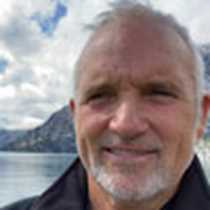We awoke just south of the entrance to Holkham Bay, the entrance to the Tracy Arm-Fords Terror Wilderness area, which is approximately 40 miles south of Juneau. The area, carved by glaciers flowing west from the Stikine Icefield, is located in the Coast Range along the Canadian border. We cruised south scanning the shoreline for bears, the sky for birds, and the water for whatever it might reveal. A distant splash of water signaled the arrival of a pod of Dall’s porpoise. These marine mammals are sometimes mistaken for killer whales but are smaller in stature. They are considered one of the fastest animals in the water. As they approached the boat, several joined us and rode our bow’s waves for quite a while. We had clear views of their acrobatic and playful behavior as we hung out heads and our cameras over the bow.
Mid-morning, several humpback whale blows and flukes caught our eye, and later a black bear was foraging along the shoreline. Shoaling water kept us at a significant distance, but most of our guests saw the bears with the aid of the spotting scope.
After a talk from our photo instructor, we ate lunch and crossed the bar into Tracy Arm. It is truly one of the most beautiful places on Earth and provides us with a view of what our distant ancestors may have seen during the last glacial maximum, approximately twenty thousand years ago. The South Sawyer tidewater glacier was our destination and, upon arrival, we launched Zodiacs and prepared to explore the icebergs floating before the glacier. Resting on the ice were hundreds of harbor seals mothers and pups. These animals use the area to give birth and to nurse their young. Their abundance made our exploration challenging as we needed to cautiously navigate around the ice to avoid disturbing them. They watched us with apprehension as we cruised slowly by.







